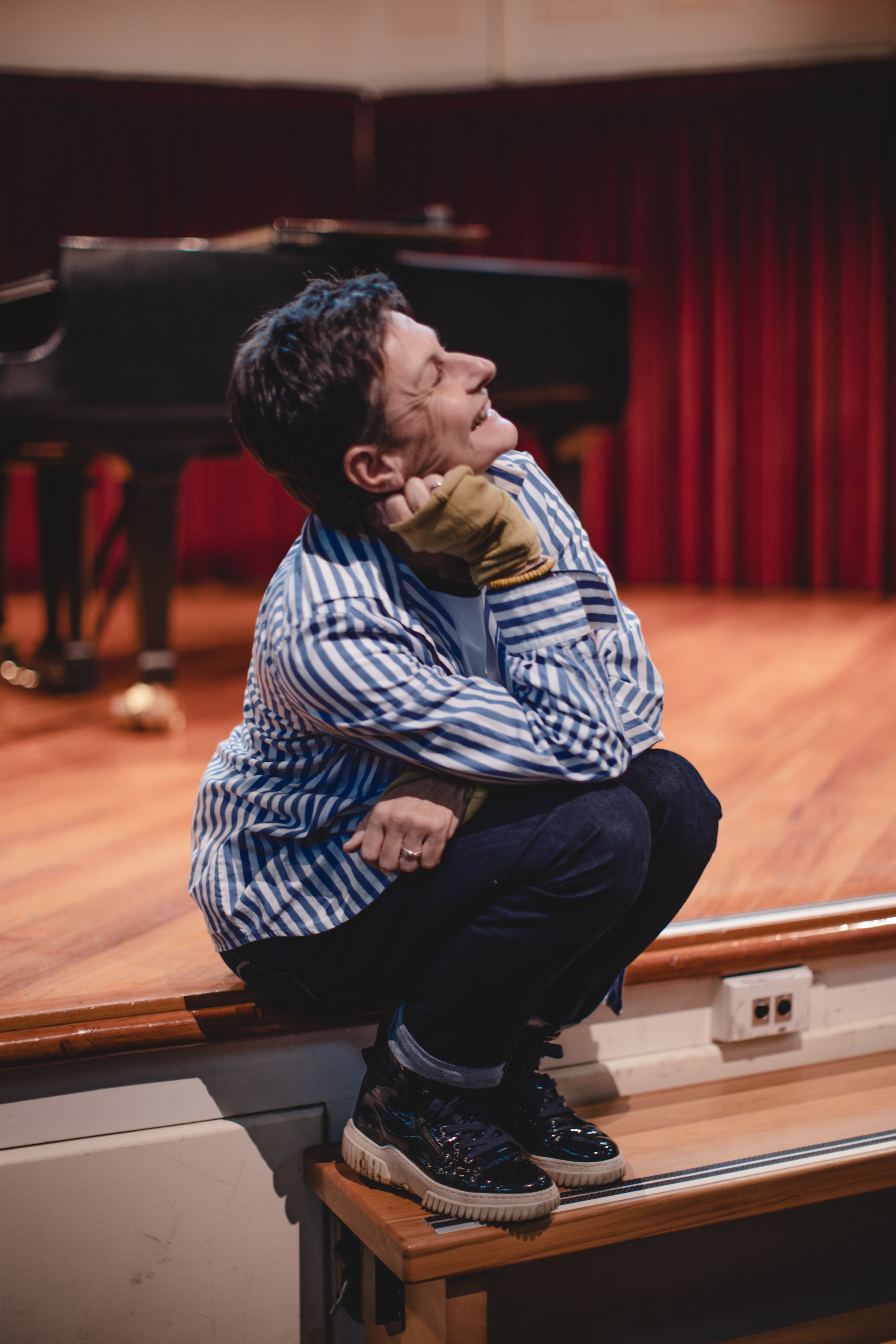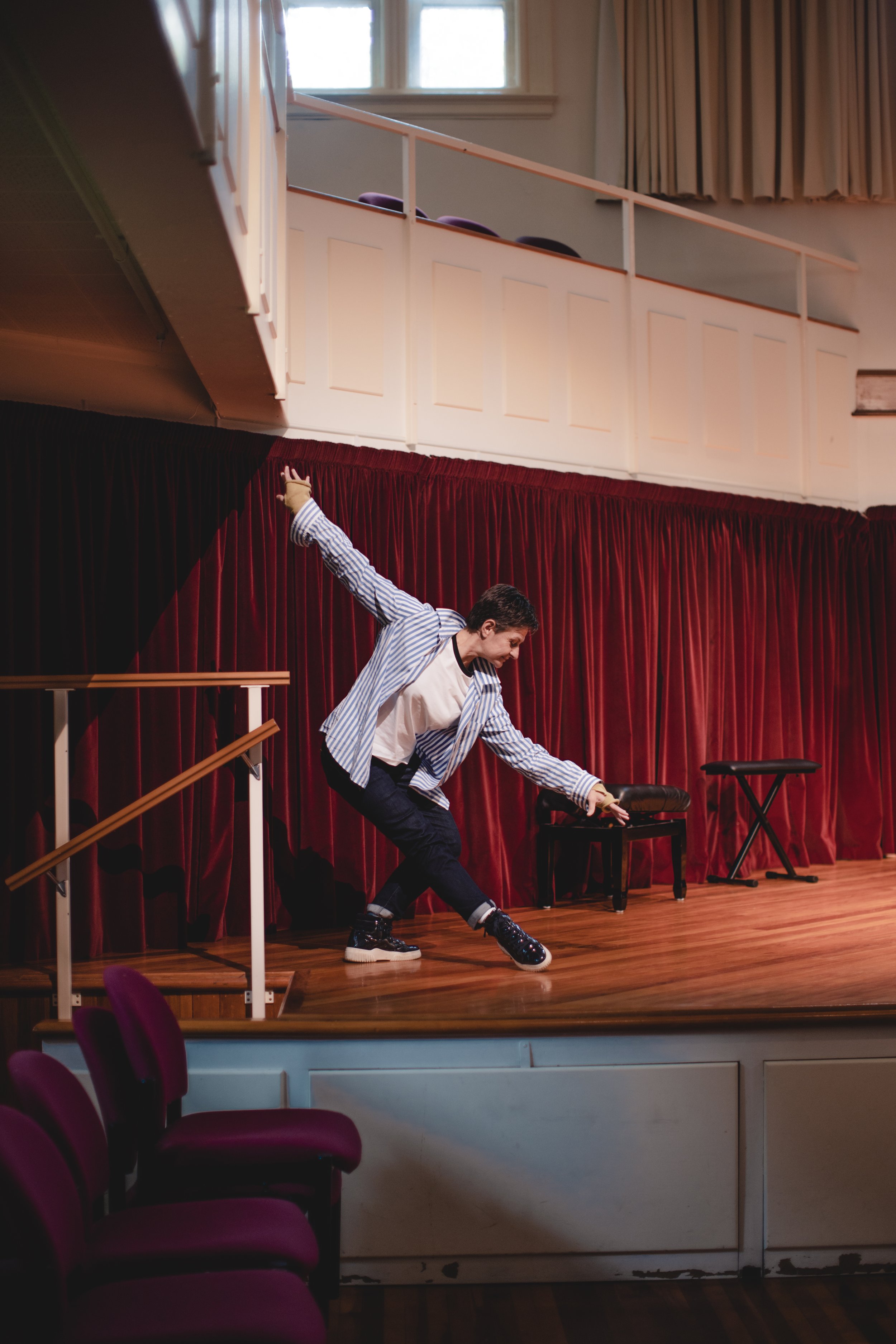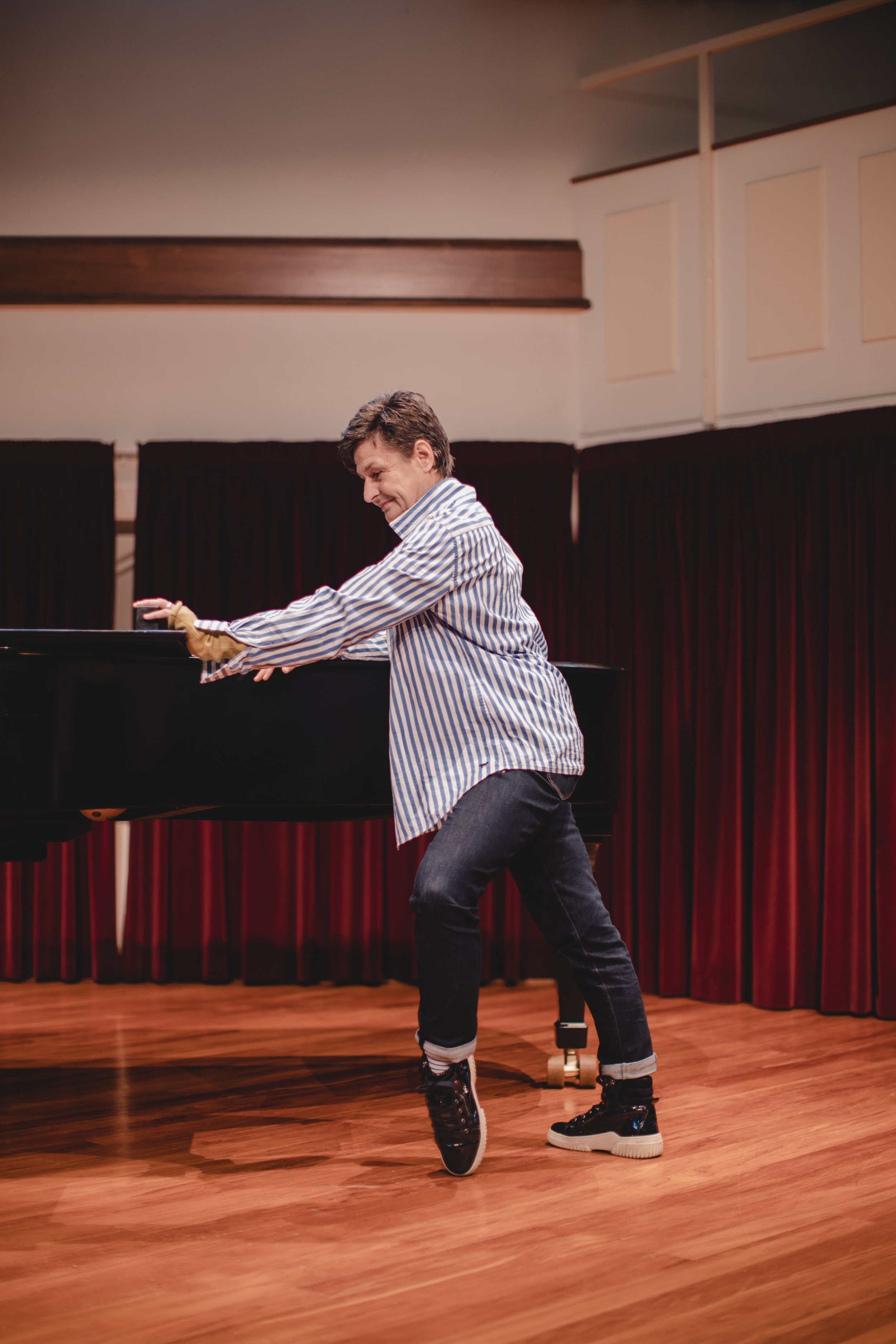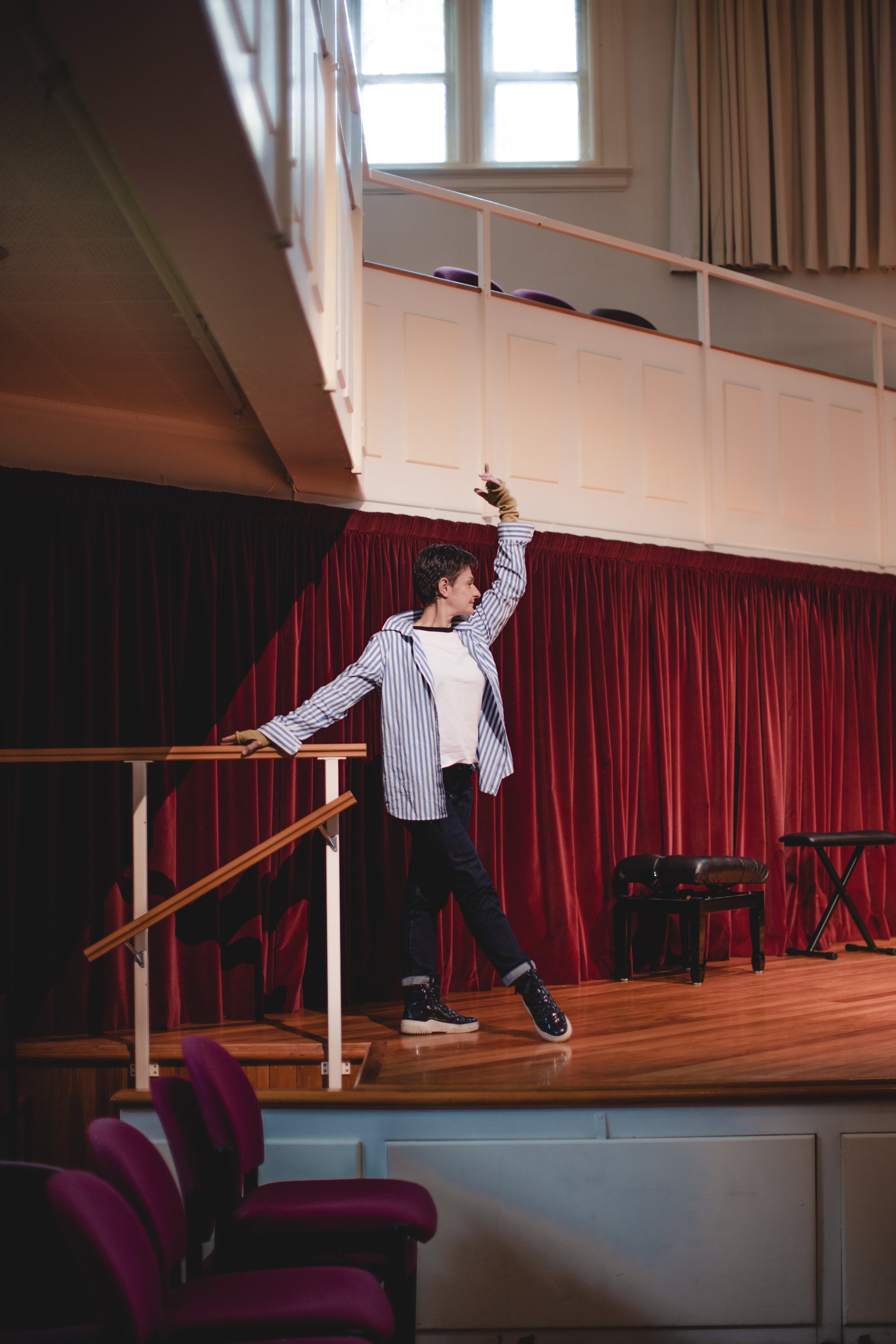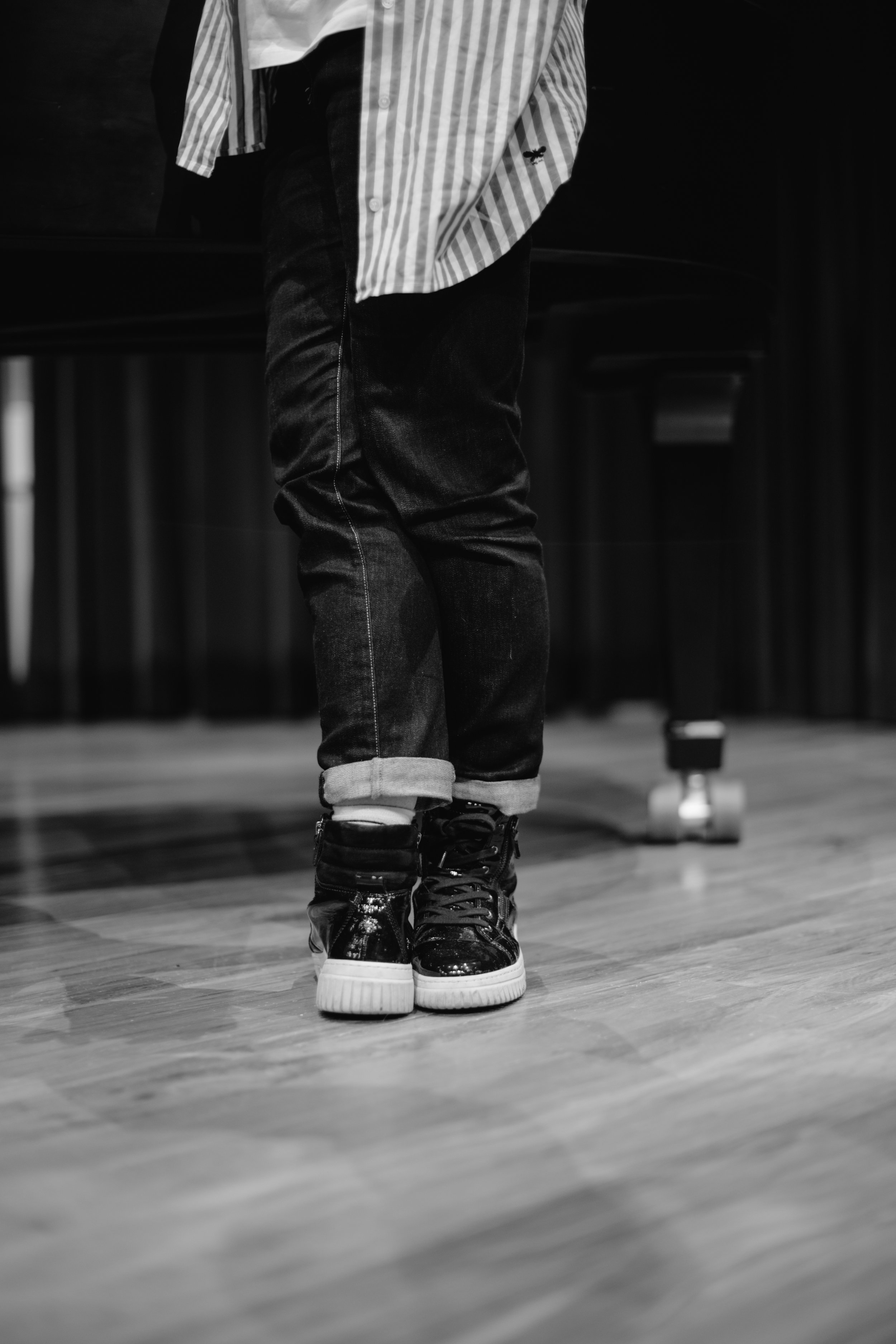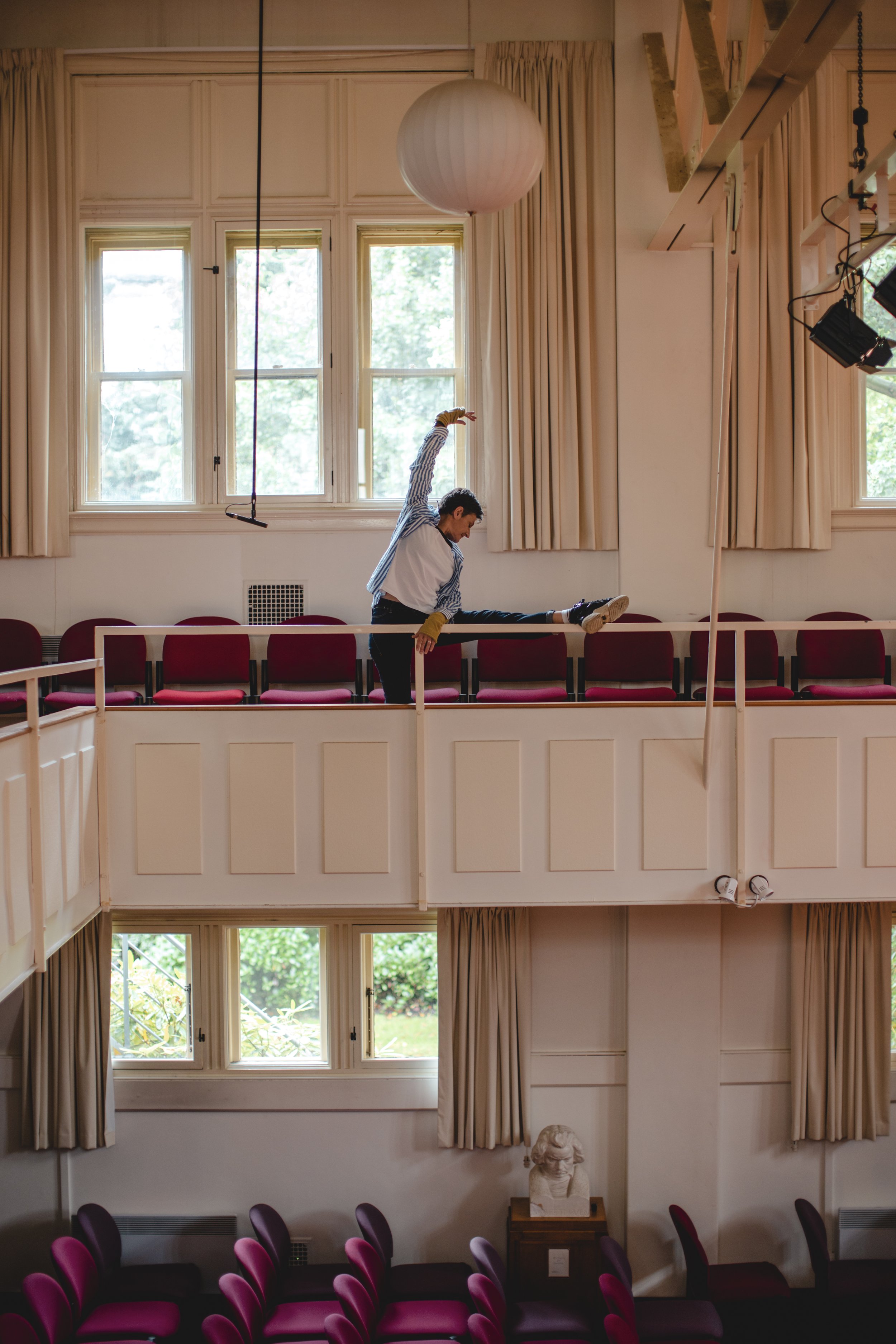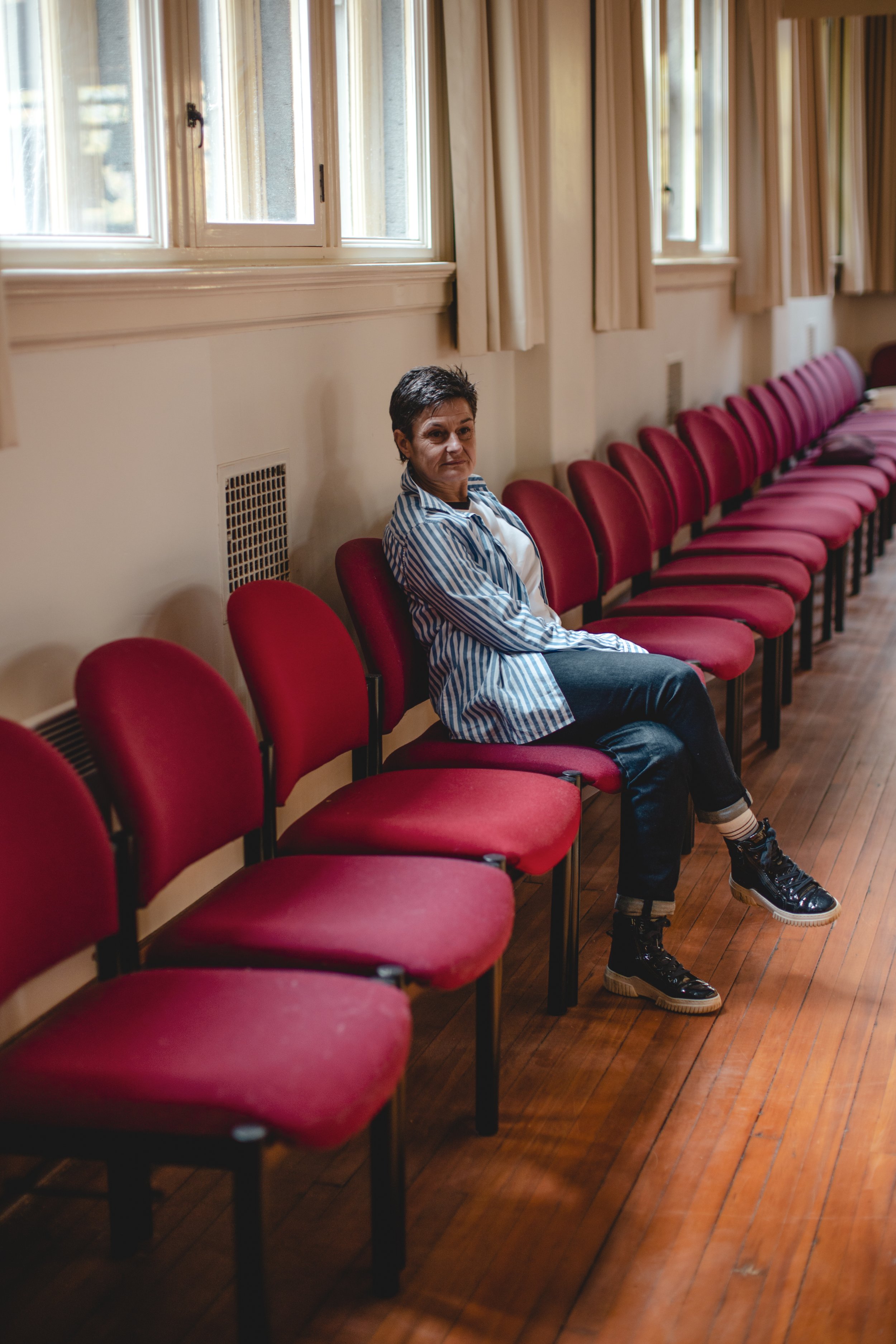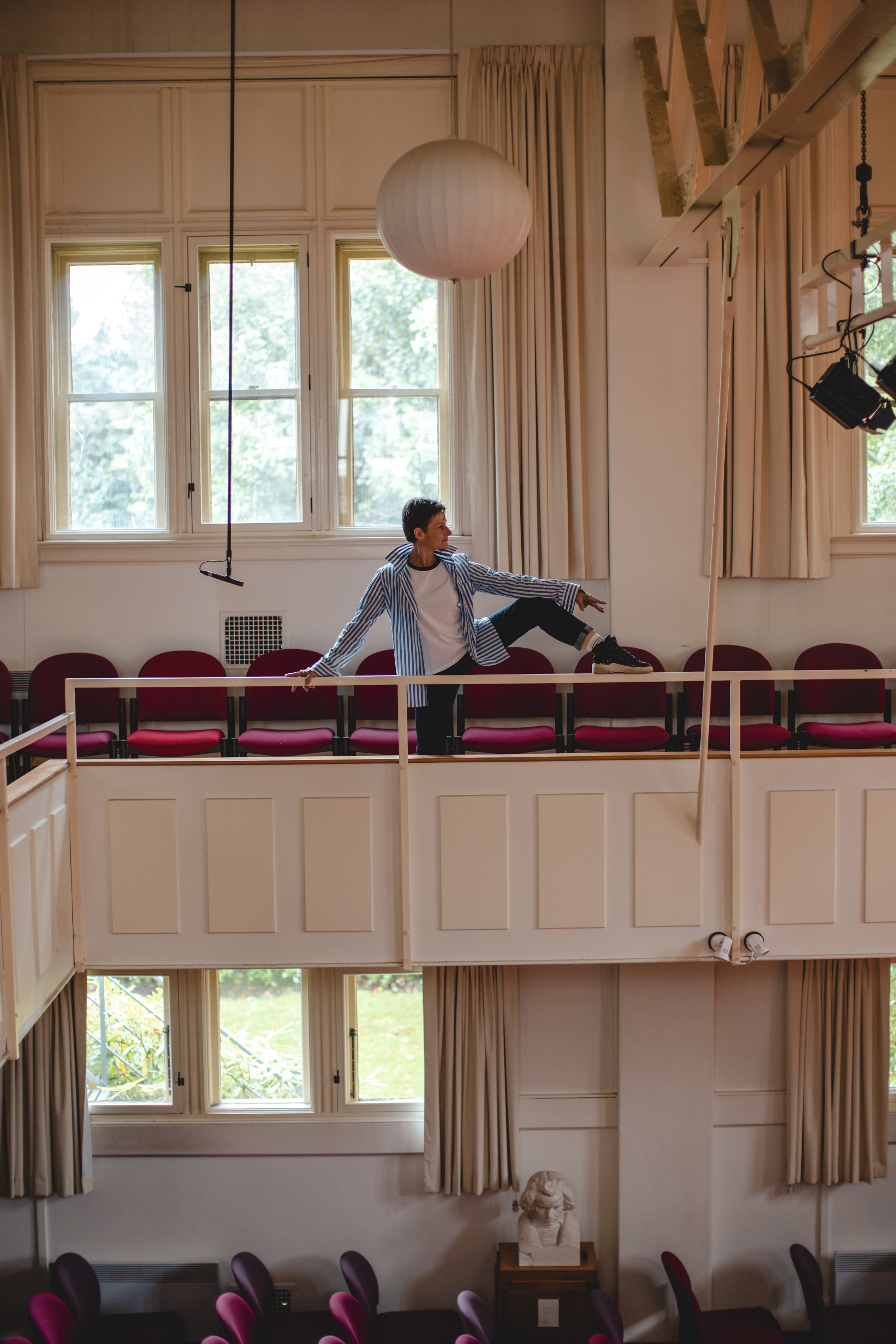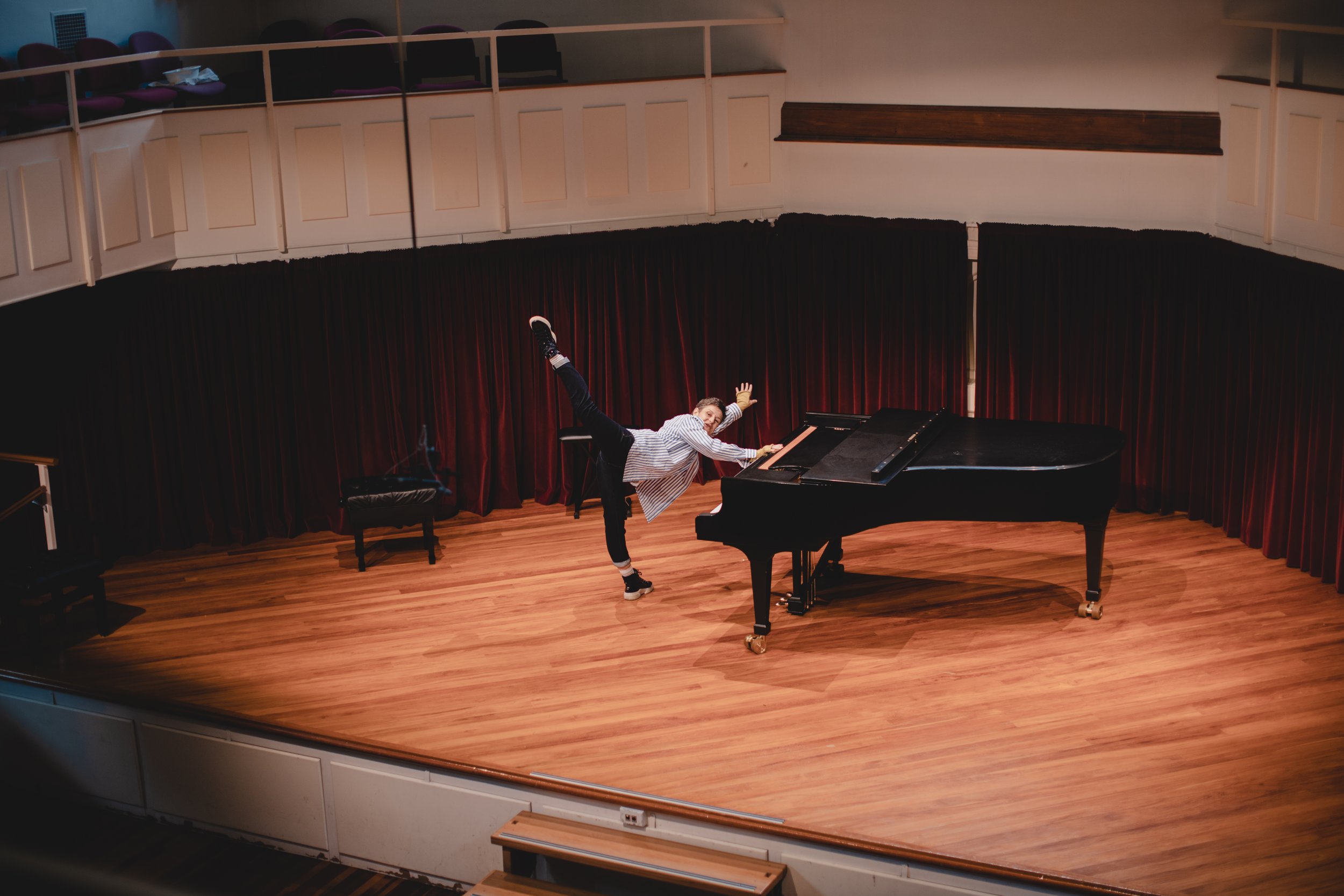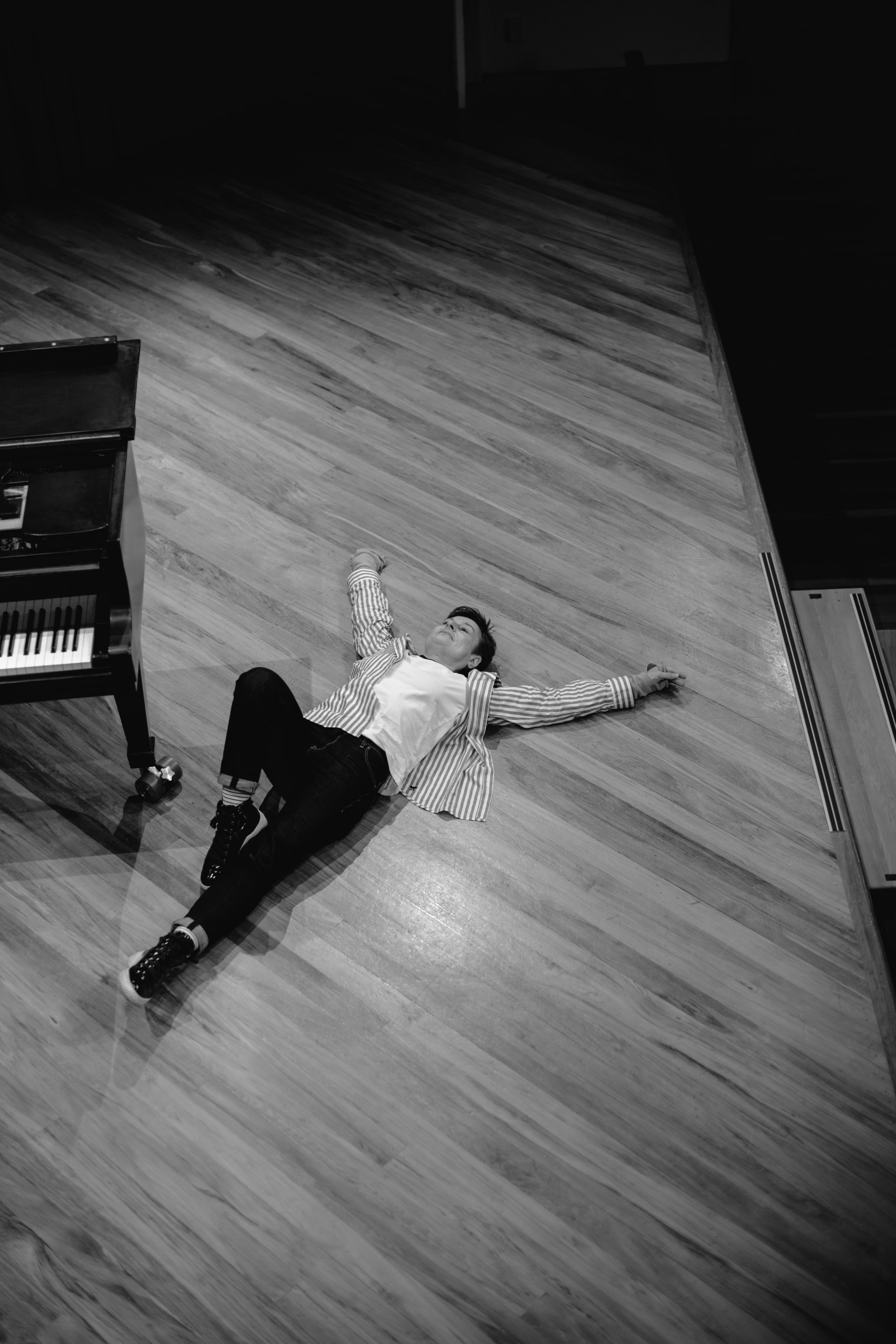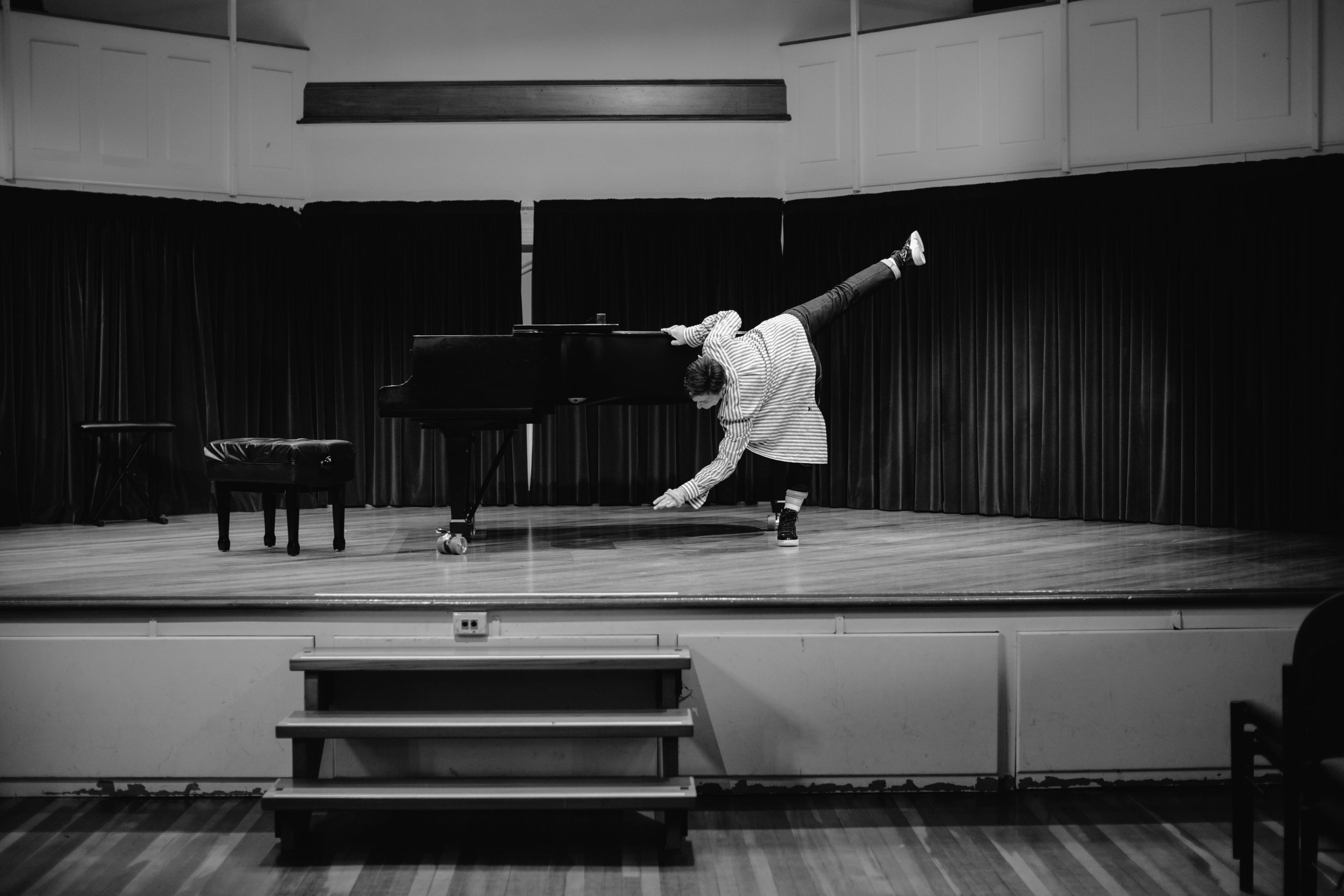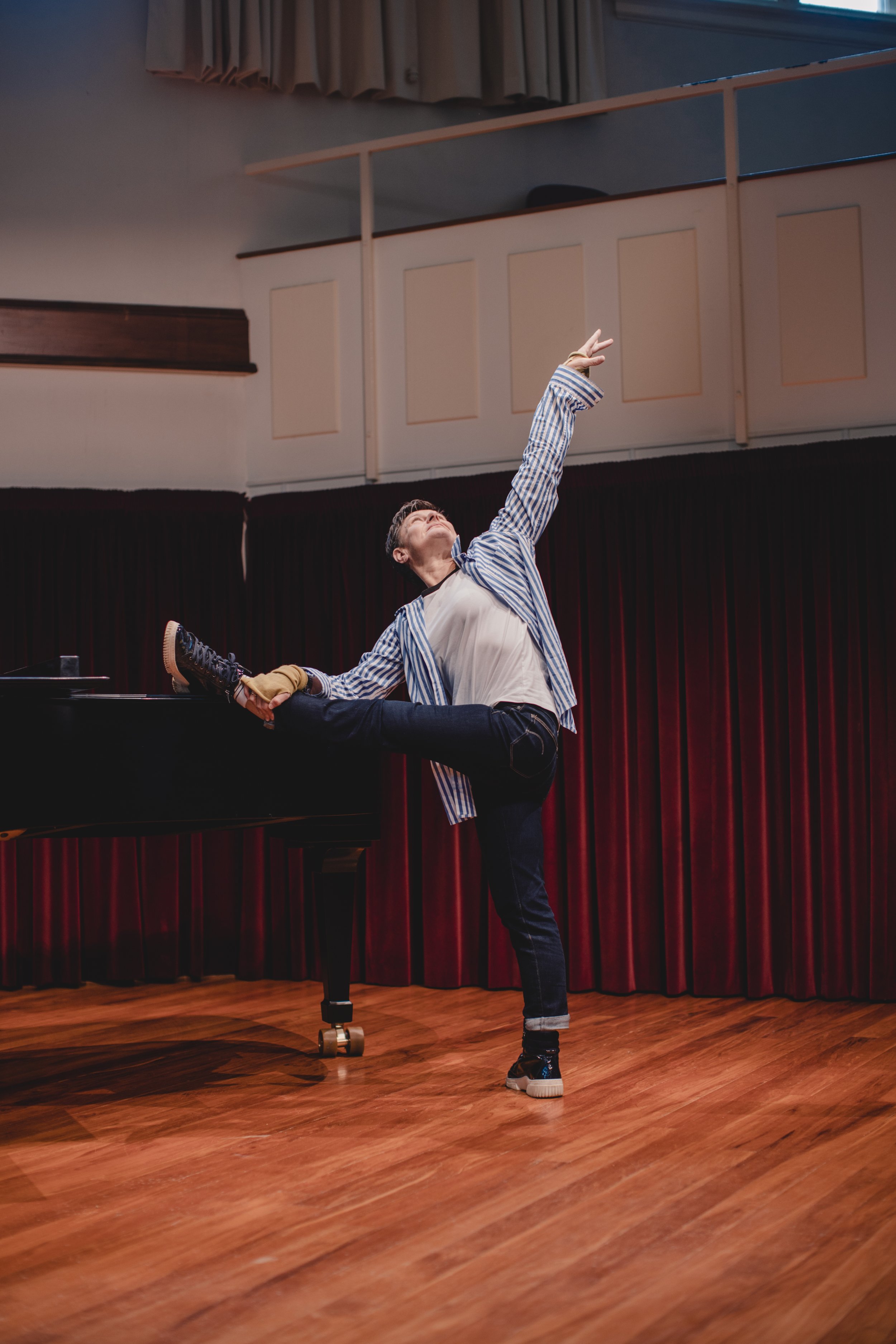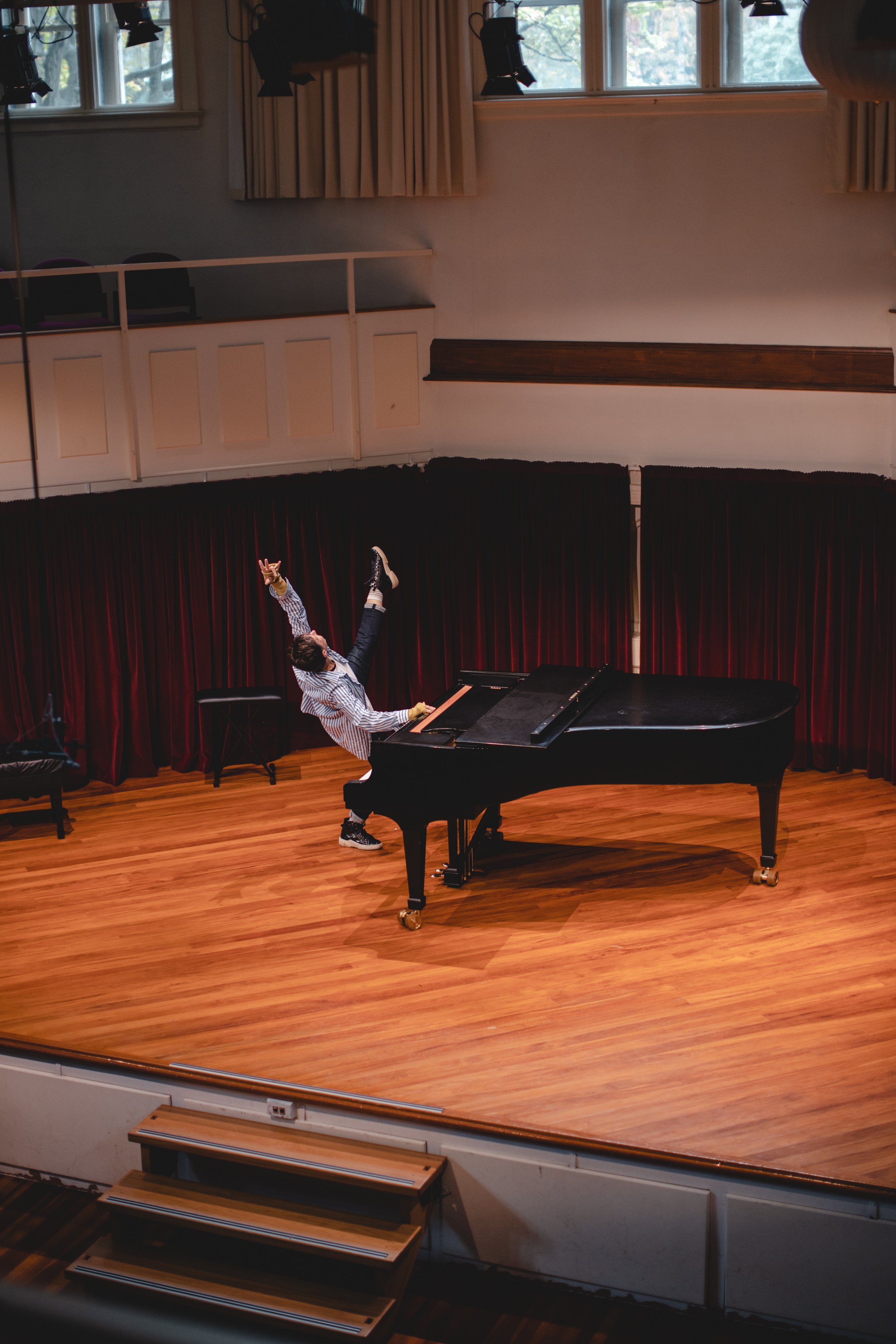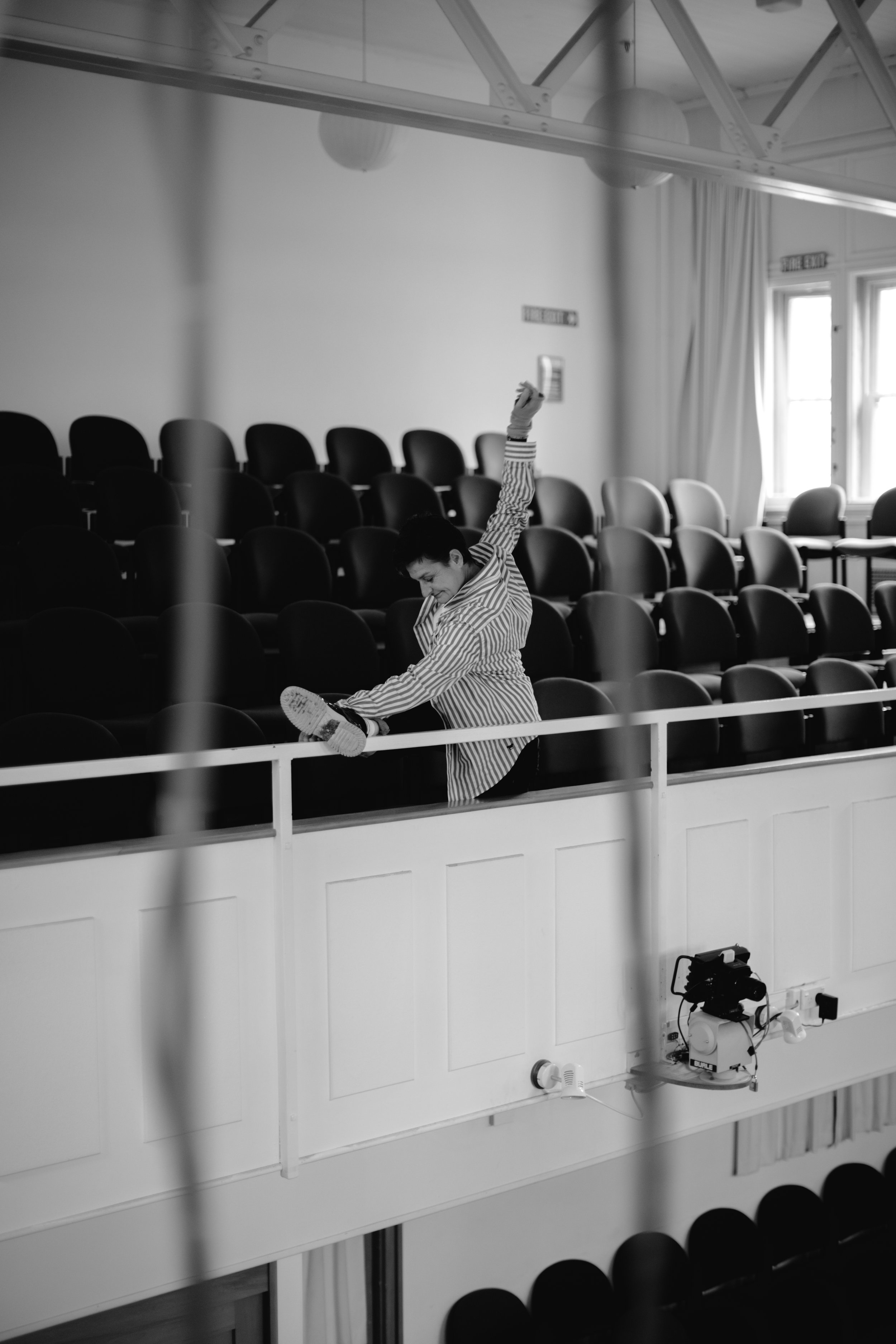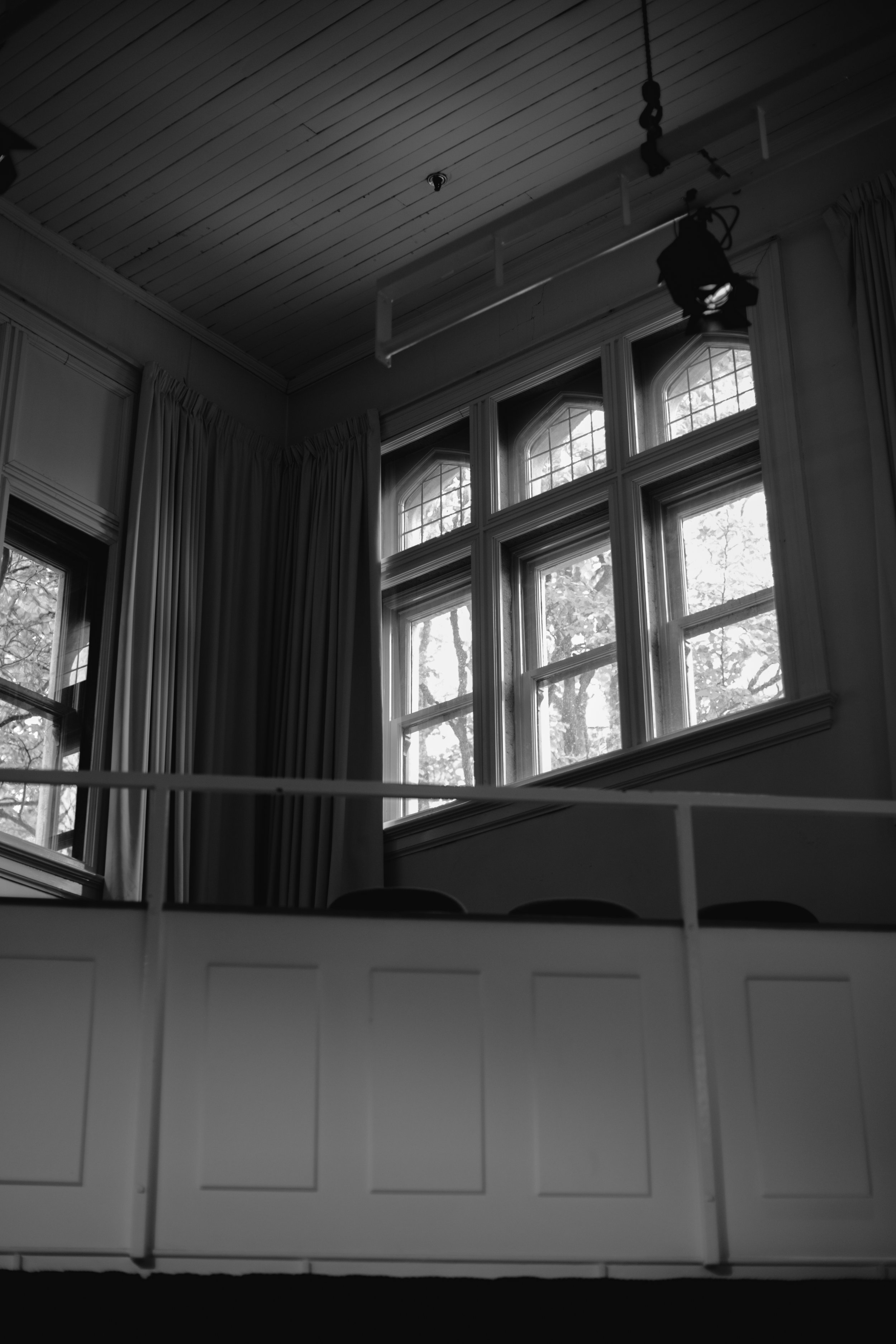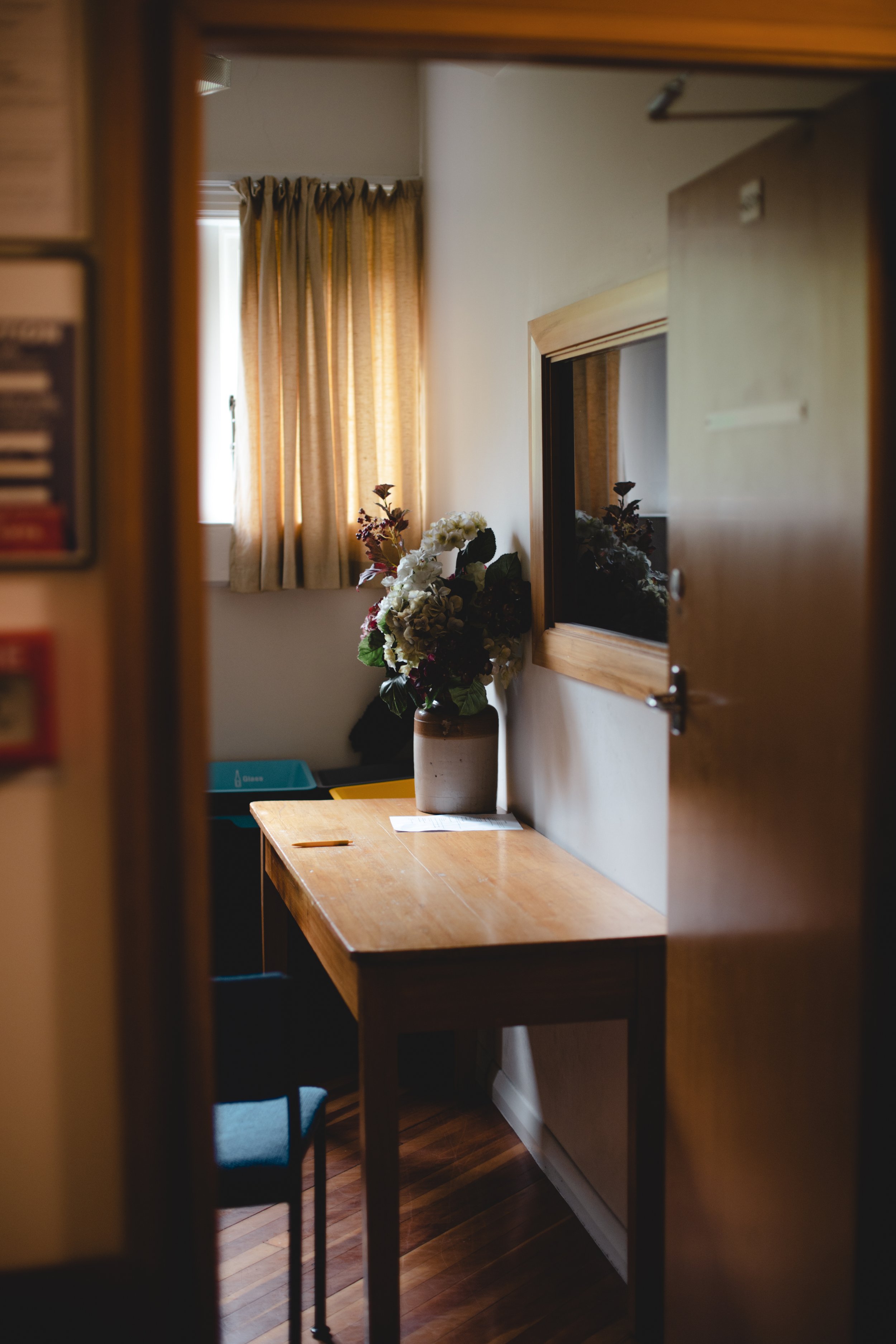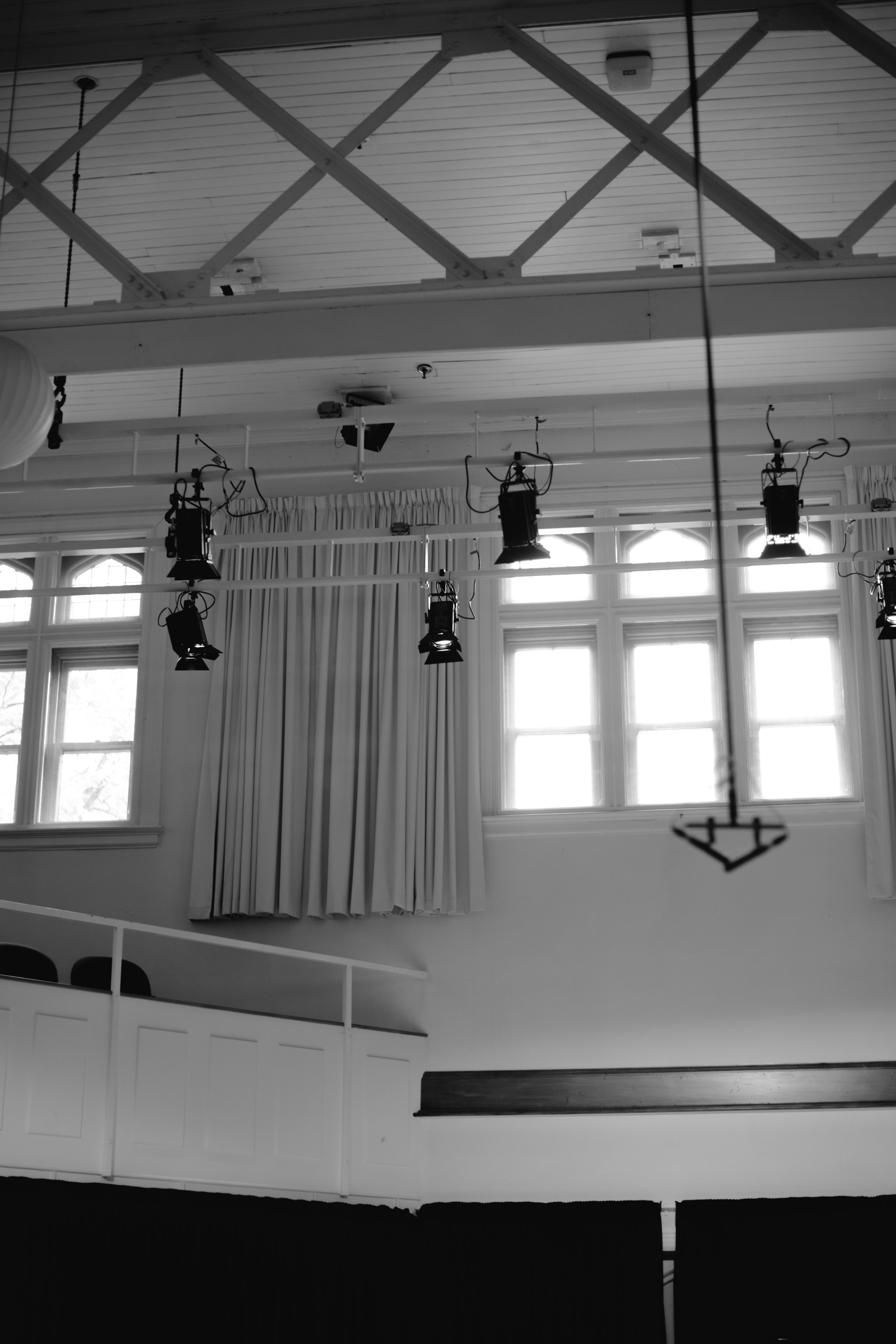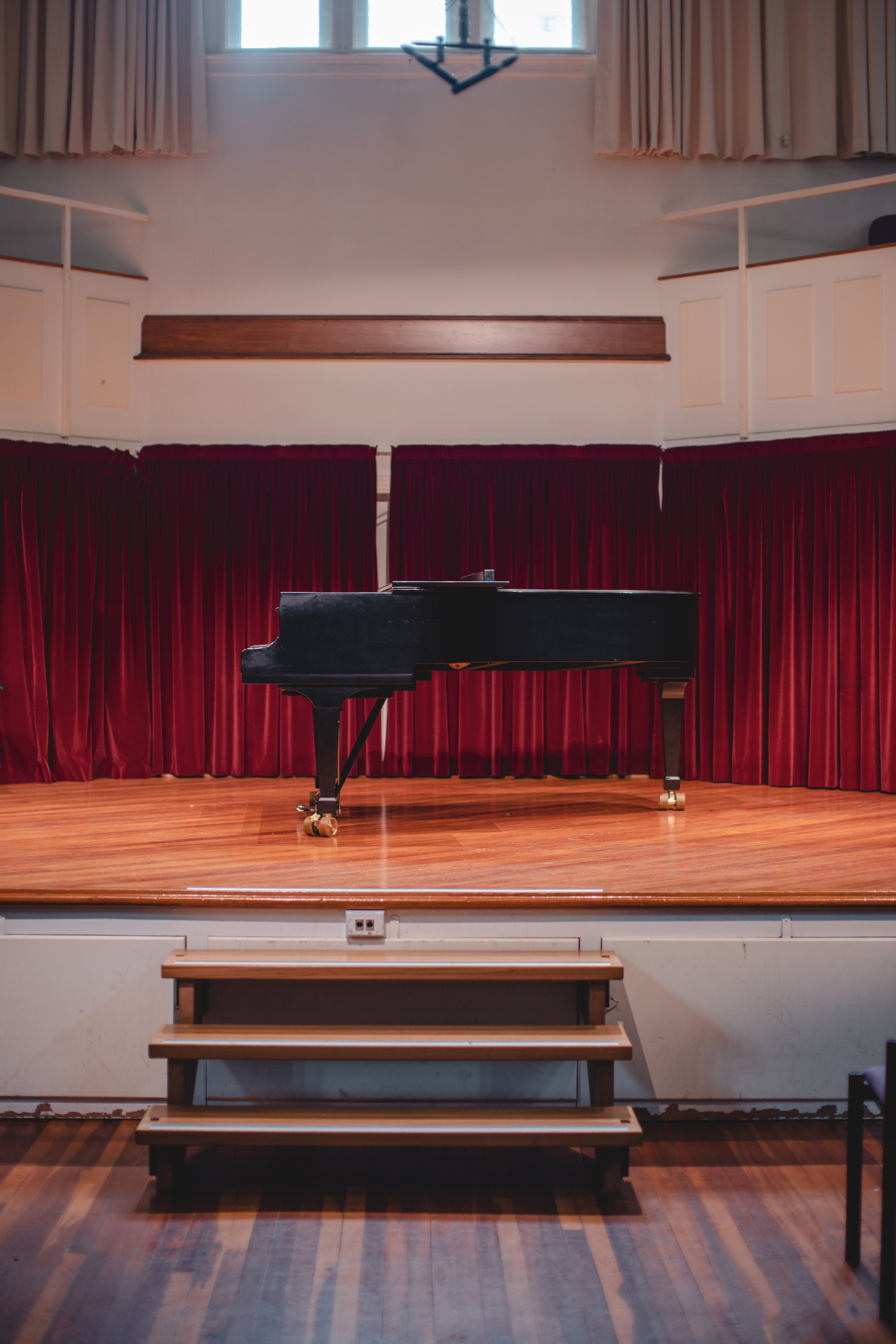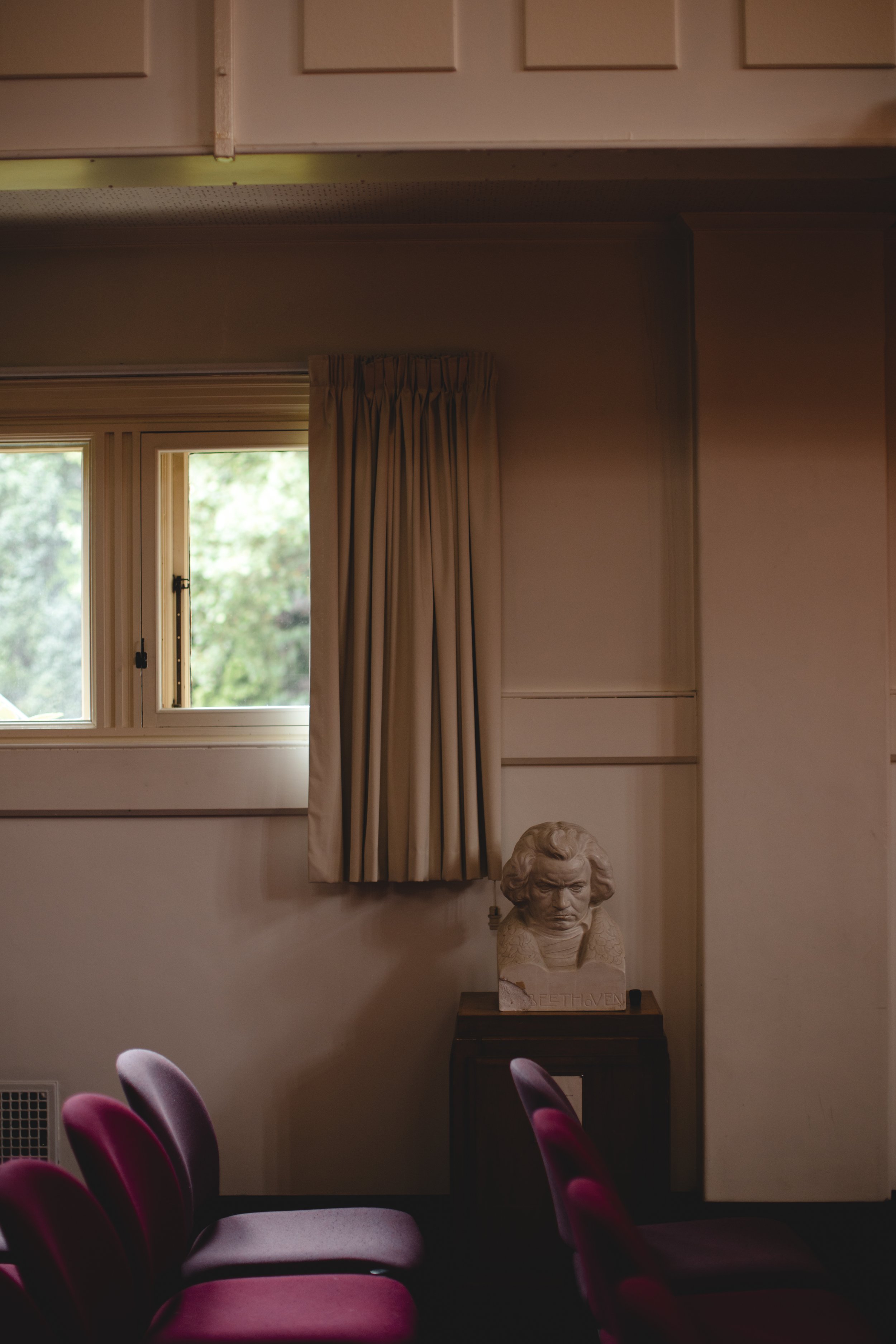A conversation with Sofia Kalogeropoulou
Back in April on a gloomy autumn’s day, I had the pleasure of photographing and interviewing the lovely Sofia Kalogeropoulou. Sofia is a senior teaching fellow at Otago University (Te Whare Wānanga o Ōtākou) and currently teaches several dance papers. Originally hailing from Greece, Sofia has travelled wide and far, with a long-spanning career in teaching that has led her to settle in the beautiful city of Ōtepoti (Dunedin). The following is a curation of our conversation accompanied with some portraits of Sofia set in the stunning Marama Hall - home of the performing arts at Otago University.
Lokyee: Let’s start with the basics, where are you from and what made you decide to move to New Zealand.
Sofia: I’m originally from Greece, then I lived in London for many years, then finally, I moved to New Zealand because my husband got a job at Auckland university.
The move was perfect because it was in a time in my career when I wanted to go back to studying dance. I had been teaching for so long, my ballet school was well established at that point, but it was getting a bit monotonous. Just doing exams and performances for the school, and I wanted a break from teaching, to go back and re-educate myself in dance and be able to go back to teaching with new, fresh knowledge. Our move to Auckland meant I could study dance at Auckland University.
There I met Timothy Gordon, and we really hit it off. He was a kiwi with European dancing experience, and I was now a European dancer gaining kiwi experience. He put me in touch with Mary Jane O’Reilly, a famous New Zealand contemporary choreographer (LIMBS company) and I had my New Zealand performance debut dancing in “spartacus”, it featured the orchestra and everything - it was quite the debut.
“I wanted a break from teaching, to go back and re-educate myself in dance."
Lokyee: So how did you end up in Ōtepoti, Dunedin?
Sofia: My husband got a job in Dunedin haha! But originally I stayed in Auckland to finish studying my BPA (Bachelor of Performing Arts), I had gotten involved with company Z, meaning I had commitments to perform in Auckland at various festivals and such. I really liked it because I had my dance community in Auckland, but after five years, I was satisfied with what I had explored in Auckland and was ready for my next adventure. So I came down to Dunedin and it was yet another downsize, Auckland was bigger and London where I had been before that for over 7 years was much bigger, so it was quite the adjustment. But there are so many dance organisations in Dunedin even though we’re so small, there’s salsa, ODA (Otago University Dance Association), bollywood etc…but we are not very unified, the Dunedin dance scene is discreet. However, the beauty of a small community is that once you meet someone, they’ll introduce you to the next and to the next and before you know it, you’re extremely well connected.
When I arrived in Dunedin, I sent my CV out, old school style, to five dance schools. It brings me back to when I was starting out in London and I had printed over one-thousand CV’s and cover letters to hand out to the thousands of dance schools in London! I had to go down to the library and look for dance school addresses in the yellow pages, write the addresses out individually and send them off, but when I got to Dunedin there were only four or five.
“The Dunedin dance scene is discreet. However, the beauty of a small community is that once you meet someone, they’ll introduce you to the next and the next, and before you know it, you’re extremely well connected.”
Lokyee: So once you were in Dunedin, how did you get to teaching at Otago University?
Sofia: I started teaching at a ballet school in St Clair, and Lisa Wilkinson of RASA (school of dance) notified the university that there was a new “experienced dance person” in town. And so the university called me up and asked if I wanted to teach a dance paper. Back then, the dance paper was part of the school of physical education before it came under the humanities under the school of performing arts, which was just a match-made in heaven. That was in 2018, since then I’ve built up that PHSE103 (compulsory dance paper for PE students) into three dance papers spanning from100 to 300 level.
Lokyee: What is something you’d like to see more between the SPA (school of performing arts) disciplines? Between music, theatre, dance and drama? Or for the dance program in general at Otago?
Sofia: What’s very exciting at the moment is that we have stronger links between dance and music. We have a couple of students in music who would like to compose music for dance. Anthony Richie who is head of the school of performing arts as well as being a famous composer himself, has a paper in music composition and we had a combined lecture on the process of composing when working with choreographers and performers. I’d like to see more of these collaborations, and to see students create with each other.
Lokyee: Lets back track a bit. Tell me about your origin story, your early days in Greece and then your years spent in London.
Sofia: I grew up in Greece and I left Greece in my twenties to move to London. I went to school in Greece, started my dance training in Greece.
My home place is Lamia - a town similar in size to Dunedin with the same kind of landscape; steep hills and near the sea with gorgeous mountains. It’s a nice little town. I started my dance training in ballet, my teacher was from Holland and we were so lucky to have her. She went against the grain of the authoritarian teaching of the time, I never had the “mean ballet teacher” experience. She was demanding for sure, she liked having a strong working ethos in class, but she motivated us to turn up and do the best that we could. She wasn’t keen on competitions either, so we didn’t have that subjective judging and competing background. Ballet was just a great outlet for me, something to do after school and socialise whilst exercising.
We had visiting teachers from London being an RAD (Royal Academy of Dance) affiliated school, and that was the tipping point for me. These visiting teachers would tell me that I was pretty cool and I started to consider a career as a professional ballerina. It was nice for my self-esteem as well.
Lokyee: So where did you go after that, when did you decide you wanted to do dancing? Or teaching?
Sofia: I started teaching at my local ballet school in Lamia. And I was torn between going into dancing professionally, or going into teaching. Teaching eventually won! I love performing of course, even now, nothing beats performing, it is an amazing experience that is indescribable just the magic that happens on stage. But I really liked teaching and passing on knowledge to other people. So I settled for becoming a teacher.
Lokyee: So then you moved to London?
Sofia: Yes! For love, I wanted to be with my partner, but also the dance opportunities in Greece were limited. London was where it was happening.
Lokyee: So what was your first gig in London? What was your first job?
Sofia: I started teaching at a couple of schools. One was in South London and one was in East London. It was a stark class difference, and I wasn’t used to these class differences, we didn’t have that so much in Greece. In East London, how can I say, the kids had to be good, they had to move up in classes, they had to do the exams and the best uniforms. Whereas in South London, the kids were there to just have fun, the expectations were very different. After a couple of years, the owner of the student moved away and asked if I wanted to buy the school - and so I did.
“I love performing of course, even now, nothing beats performing, it is an amazing experience that is indescribable just the magic that happens on stage.”
Lokyee: And how old were you then? When you bought the school?
Sofia: 22
Lokyee: But that’s so young! That’s crazy. Twenty-two years old and you bought the dance school.
Sofia: Yes. It was the school in East London. It was quite insane. But I didn’t actually buy the building, location or the people. I just bought the name of the school. I bought the rights to say to the parents that I am now the owner of the school. We moved to another location, so really started from scratch. I’ll never regret it, it was an incredible experience, I never thought I would like to run my own ballet school. But the opportunity came about and I saw it as a challenge. That’s what I tell my students - give something a go, even if you decide that it isn’t for you, test the waters and see how capable you are of doing something. I managed to grow the school to about 120 students, and got some other teachers in, had piano players.
Lokyee: Having piano players in the class. What a treat.
Sofia: I know. That was one of the things that I preferred to compromise on the money making, it just makes class so much better. To learn with the music. We were so privileged. It makes teaching much easier, no technological difficulties there haha. It helps the kids develop musicality for both me and my students.
Lokyee: That’s what I really miss about ballet sometimes, is getting to dance with the live pianist. It’s so good.
Sofia: That’s what I feel dance students miss out on these days. I can see that my students expect the music to be exactly the same everytime. But no, every human playing is going to be different. It’s like different communication styles and developing awareness and training the ear to listen to have the ability to slow down and react.
Lokyee: Right, to play with the music. To improvise.
Sofia: Yes, exactly that. It’s nice to have that chance to play.
Sofia Kalogeropoulou
“What I like about Dunedin, is that it is a small place, but there is always something happening. There is always that community vibe. I always make plans in my head of how I would like to make dance a more solid program within the university and for me I see that as making better connections between the SPA disciplines. I have the experience and I have the ability to give tools and skills to young artists.”
Lokyee: What would you like to see next for dance at Otago? Dance in Ōtepoti?
Sofia: I see things like ODA, and I see how student-led clubs bring the freshness, the enthusiasm and the vitality. When I was 17, all I wanted to be was in the studio, and I see that with the dance club. But in terms of the dance program, I want to attract more students, both national and international students, I think we have a real opportunity to teach New Zealand dance. It’s exciting to hear from students and academies overseas who are interested in New Zealand dance, who want to visit New Zealand and study here. I want to see Otago provide for that, to figure out what a distinct New Zealand dance training is, or dance training that is underpinned by New Zealand values, for people to come here and learn something Aotearoa specific.
I want to see more Pasifika and Māori choreography as well. There has been some beautiful work recently by Māori and Pasifika artists and there’s a lot we can learn from there.
I want to make New Zealand a place for international artists to exchange ideas and for international choreographers to work with our students. That’s one of my aspirations for dance at Otago. To create a program that teaches New Zealand dance specifically, making Aotearoa a drawcard for international artists and an attractive place for students and scholars to learn and teach.
“It’s exciting to hear from students and schools overseas who are interested in New Zealand dance, who want to visit New Zealand and study here. I want to see Otago provide for that, to figure out what a distinct New Zealand dance training is, or dance training that is underpinned by New Zealand values, for people to come here and learn something Aotearoa specific. ”
Lokyee: Second to last question, do you have a word of advice for dancers wishing to pursue a career in the arts? or teaching?
Sofia: I would say, go for dancing first, if that’s what you enjoy. Give it a good go, when you’re young and you have the energy and the drive and the passion, go and perform. Take chances. Don’t be self critical, just go for it.
All photos taken by Lokyee Szeto.
Lokyee: Okay. Last question, what would you like to see change in the Aotearoa dance scene?
Sofia: I want to see more collaboration and conversations between various institutions. There is a lot of dancing happening but a lot of silos. We need to fix those breaks, and altogether we need to figure out what makes New Zealand dancers special. There is so much talent here, how do we foster that, champion that? We need to give credit to the local dance teachers and the amazing young dancers that they train. But how do we create a viable industry, a performing, teaching industry for these young, talented dancers so they don’t all have to go overseas.




